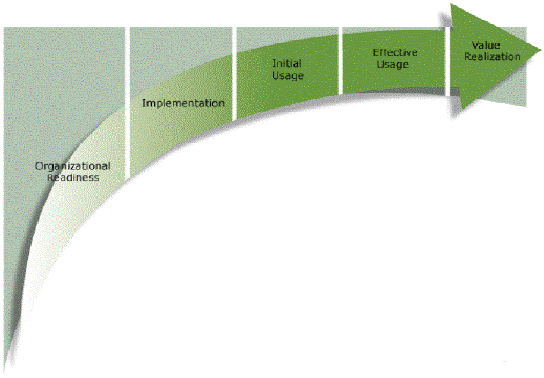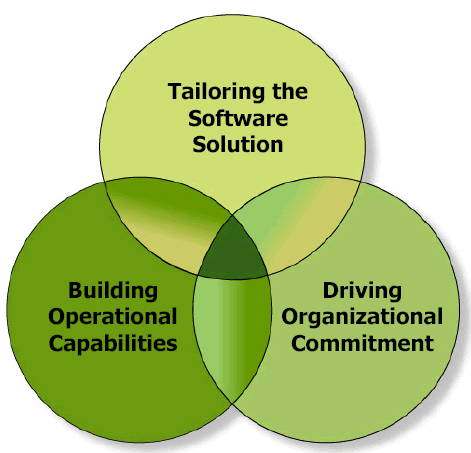By Chris Dowse, Founder & Chief Executive Officer, Neochange, Inc.
Effective IT Adoption may not be a familiar term. Essentially it is a
proxy for business value and is characterized by the following attributes:
-
Core functionality that is measurably connected to business outcomes
- A high percentage (85%+) of targeted users actively engaged with core
functionality
- Sufficient levels of high-quality data to provide actionable insights
In our work I’ve found that the majority of enterprise buyers believe that SaaS
delivers faster, cheaper and higher rates of Effective IT Adoption than
on-premise software. By logical extension they expect faster time-to-value and
larger improvements in business performance. Both these expectations seem
reasonable given the marketed advantages of SaaS: Faster deployments, lower
implementation costs, simpler functionality and ubiquitous access.
But, back to Gartner’s prediction, are these expectations grounded in reality?
In short, I don’t think so. SaaS is likely heading for an Effective IT Adoption
expectation gap because of one key assumption that enterprise buyers often make:
the assumption that the software by itself can deliver Effective IT Adoption in
complex business environments. Clearly, this assumption is unrealistic when you
consider the collective social complexity and change capacity of hundreds or
thousands of users. Imagine, the myriad of competing needs and interests that
are typically associated with enterprise software deployments and then factor in
the volume of competing initiatives that are concurrently in play.
Even so, like any expectation gap there are insights that, if understood and
acted upon, can narrow the gap without the necessity of setting our sights too
low. The following three insights are critical to closing this expectation gap
and will enable enterprise buyers to capitalize on the strengths of SaaS to
deliver significant business value.
Insight #1: The Adoption Process is Longer Than You Think
As early as the ’60s, studies of ‘technology’ adoption have concluded that there
is an
organizational adoption process (see Figure 1) that, if followed, increases the
likelihood of initiative success. Software initiatives that adhere to this
process achieve faster and greater business value.
Unfortunately the majority of attention, and therefore investment, tends to
focus on just one phase of this process – the implementation phase. This narrow
approach is one of the key contributors to a lack of Effective IT Adoption. The
following aspects of the process warrant further mention to broaden our focus.

Figure 1
I. Skipping the Readiness Phase Ironically Delays Time-to-Value
In our short-term centric world, many organizations skip the critical stage of
aligning
commitment to a software-enabled change. In addition, little thought is given to
the implications of process changes required or dictated by a software
deployment. Ironically, the perceived up front time-savings are more than offset
during and after implementation. This occurs because higher levels of user
resistance are encountered and unknown impacts disrupt operations and derail
desired benefits.
II. Effective Usage Requires Ongoing Investments and Attention
In reality, most significant, sustainable changes take about 18 months to take
hold and settle into the bottom line. Many organizations often use all their
money and ‘attention capital’ in the implementation stage and fail to achieve
full value realization. To achieve full value realization ongoing investments
are required for areas such as training and support. Also, executive sponsors
need to continue managing ‘mind-share’ after deployment by communicating to
employees how effective usage is benefiting the organization.
III. An Organization’s Capacity for Change Dictates How Fast Benefits Can be
Realized
Capacity for change is the limiting factor for organization’s attempting more
than just automating business as usual. Many organization’s struggle because
their leadership/management teams are adept in functional disciplines (sales,
product development, etc.), but less so in the discipline of change. A related
misunderstanding is the perception that change leadership can be delegated to
the core implementation team, it cannot. Change leadership is a shared
responsibility through all levels of management.
Insight #2: Good Software Isn’t Enough
More than 80% of the factors that drive Effective IT Adoption have nothing to do
with the software. Therefore to be successful, organizations need a more robust
discipline than traditional software deployment methodologies. Specifically, a
more integrated discipline (see Figure 2) would address the complex
interconnection between the software solution, the operating capabilities of the
host environment and the organizational commitment to software driven change.
The following are three key areas of focus, which if executed in parallel
deliver Effective IT Adoption.

Figure 2
I. Driving Organizational Commitment
Managing expectations and concerns accelerates Effective IT Adoption and helps
avoid unnecessary adoption risks. Ideally, organizational commitment efforts
will position stakeholders as owners of software-enabled process change and less
as its victims.
-
Market the Value – quantify and repeatedly communicate the value of effective
usage to the organization and develop “what’s in it for me” messaging for
critical stakeholders
- Proactively Influence Stakeholders – create opportunities for stakeholder
involvement, design usage metrics and incentives to align behavior towards
buy-in
- Maintain Strong Governance – execute active executive sponsor involvement,
define performance outcomes to direct and track success, hold managers
accountable for progress
II. Building Supportive Operational Capabilities
-
Developing supportive operational capabilities significantly enhances a software
solution and requires more effort than just software usability training.
- Refine the Operating Model – formally assign decision rights, define new roles
and ensure responsibilities are understood, revisit organizational structures
- Enhance Change Leadership – develop manager’s communication and expectation
management skills, assign dedicated transition management resources
- Develop User Skills – enhance domain specific skills, increase decision
management competency to provide actionable insights
III. Tailoring the software solution to the unique character of the host
organization
Tailoring the solution requires more than just defining feature requirements.
Keeping the organization’s unique culture and business needs at the forefront of
solution deployment decisions increases the likelihood of success.
-
Consciously choose the process maturity jump – decide whether you are automating
business as usual or increasing process capability, understand the impacts of
process maturity jumps, invest in workflow and data models before deploying
software
- Focus software enabled capabilities on high-value areas – define a combination
of pain points and desired business capabilities to prioritize functionality
deployment, deploy functionality that is highly valued by front-line employees
early to create momentum
- Develop Capability-Based Deployment Plans – account for internal deployment
bandwidth, factor in time to stabilize the foundational functionality
Insight #3: Too Much of a Good Thing Can Hurt You
Like most things, strengths become weaknesses when they are taken to the extreme
without consideration for unintended side effects. Currently, the SaaS model
places a premium on speed, simplicity and customization. These strengths can
undermine the end goals of a software initiative if enterprise buyers let them
proceed without limits. Enterprise buyers should keep an eye on the following:
I. User ‘Feature Fatigue’ from Faster and More Frequent Upgrade Cycles
Software vendors tend to think of upgrades as a good thing for customers. The
logic is more functionality equals more benefits. The SaaS model allows for
accelerated release cycles. When these release cycles are constantly used for
functionality and usability enhancements users can become disgruntled with their
moving target and disengage from using the software.
II. Increased Organizational Complexity from Multiple Configurations
In large enterprises, various divisions/departments have specialized business
needs for their software. The ease of user-driven configuration with the SaaS
model can result in some organizations having many different configurations in
their organization. This is problematic for organizations that are attempting to
drive process consistency across the enterprise. Also, ‘power users’ driving
configurations can chase off mainstream users who declare the deployment too
complex and/or cumbersome.
III. Fragmented Business Disciplines from Incomplete Process Coverage and Siloed
Data
SaaS price points and functional simplicity are enablers for grass-root, viral
adoption. As the software expands into the organization some users conclude that
the deployed functionality is incomplete in the context of their entire business
discipline. In addition, the absence of IT involvement can result in siloed data
that prevents actionable insights being developed. Both these potential adoption
risks create the perception that the software is less valuable to the
organization, which ultimately results in users opting-out.
High Achievement Occurs in the Context of Unrealistic Expectations
While I have stated that I believe the expectations of SaaS delivered software
are too high, I also believe the obvious benefits of the SaaS model suggest we
should not drop our sights too low. If we accept that the software itself is
just one actor in a much more complicated drama then it should be clear that the
three insights discussed need to be addressed.
Progressive enterprise buyers will close the expectation gap by harnessing the
strengths of SaaS and by spending more energy addressing the areas that have
traditionally plagued software deployments. Inevitably, this will involve
redirecting deployment savings into activities that promote Effective IT
Adoption before, during and after implementation.
This is not a trivial effort. In fact, for some it will require a complete
paradigm shift. But in our world of technology-driven change we must all adapt
and evolve to survive – those who do will unleash the full benefits that the
SaaS model has to offer.
Chris Dowse is Founder and CEO of Neochange, the leading
management consulting firm focused exclusively on the complex challenge of
Effective IT Adoption. The company is based in San Francisco with resources in
the UK and Australia. It developed the innovative Adopt IT TM methodology and
has consulted with executives of Fortune 500 companies such as Wells Fargo,
Cisco, DirecTV and McKesson to help mitigate adoption risks and manage business
transformations in the areas of IT management, CRM/SFA and Enterprise Risk
Management. Neochange is also retained by industry-leading ISVs ($20M to $1BN in
revenues) to develop and execute their user adoption solutions/practices. Chris
is a cited industry thought leader on organizational adoption and
software-driven transformations. His research and opinion papers have been
published in various technology channels such as Information Week, SoftwareCEO
and Sandhill.com. He frequently presents at C-level events and round tables on
the leadership challenges associated with transforming software companies and
corporate IT. For article feedback, contact Chris at
inquiries@neochange.com
 

|

